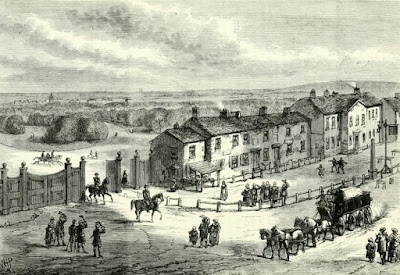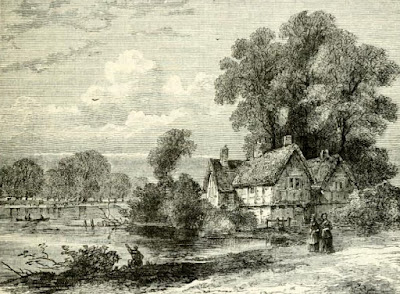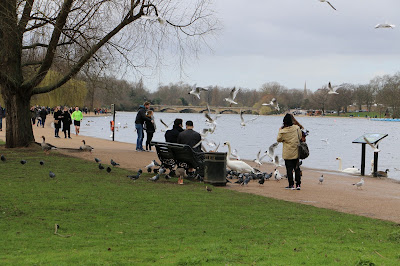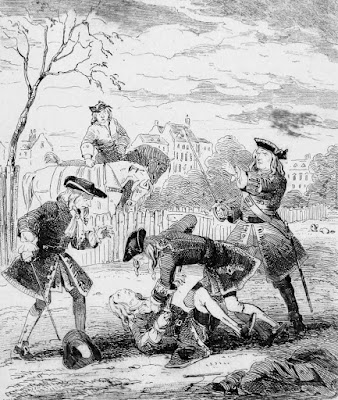 |
| Hyde Park on Sunday from Modern London by R Phillips (1804) |
Old and New London described Hyde Park as:
… that most famous of recreation-grounds, and chief of the ‘lungs of London’, which all the world, to this day, persists in calling ‘the Park’, as if we had no other park in our metropolis—no doubt because, in the Stuart times, and even later, it was the only park really open to the people at large.1
 |
| Hyde Park Corner in 1750 from Mr Crace's Collection from Old and New London by E Walford (1878) |
Fanny and I went into the Park yesterday & drove about & were very much entertained.2
According to Crosby in A View of London (1803-4), Hyde Park was:
… a royal demesne, containing about 395 acres. It is situated at the western extremity of the metropolis, having the road to Oxford on the north, and the road to Hounslow on the south.3
The land on which Hyde Park lies originally belonged to Westminster Abbey and was acquired by Henry VIII at the time of the Reformation. He enclosed the land and stocked it with deer to form a private hunting ground.
Charles I first opened the park to the public in 1637. He created the Ring where members of the royal court could drive their carriages. During the English Civil War, it was sold off in lots, but the crown reacquired the land after the Restoration. The park was reforested and restocked with deer and enclosed with a brick wall.
During the Great Plague of 1665, large numbers of poor people who could not escape the city camped out in Hyde Park in an effort to avoid catching the disease.
In 1689, William and Mary bought Kensington Palace, on the western edge of Hyde Park, and made it their London residence. The king created a direct route through Hyde Park to his new palace and lit it with 300 oil lamps. This was known as the King’s Road, and was the first artificially lit roadway in England.
 |
| Map of Hyde Park from The Story of the London Parks by J Larwood (1874) |
The creation of the Serpentine
During the reign of George II, Hyde Park changed dramatically. Some 200 acres were added to Kensington Gardens and Queen Caroline employed Charles Bridgeman to help redesign the parks. Bridgeman dammed the Westbourne River to form the Serpentine.
The Picture of London for 1813 wrote:
This park is a spot of great natural beauty, heightened by a fine piece of water, called the Serpentine River, formed into a wide canal in 1730, by enlarging the bed of a stream flowing through the park, which, taking its rise at Hampstead, falls into the Thames at Ranelagh.4
According to The Picture of London for 1813:
Hyde Park is open every day in the year, from six in the morning till nine at night, to all persons. No horseman is excluded; nor any carriage, but hackney-coaches or stage-coaches. There are five gates opening into Hyde Park, the principal of which are, Cumberland-gate, at the western end of Oxford-street; Grosvenor-gate, in Park-lane; the gate at the western extremity of Piccadilly, called Hyde Park Corner; and the gate near the entrance of the village of Kensington.5
 |
| Entrance to Grosvenor Street from Hyde Park c1780 from Old and New London by E Walford (1878) |
The most beautiful part of the park was judged to be the north-west enclosure. The Picture of London for 1810 wrote:
An inclosure of this park, on the north-west corner is extremely beautiful. This spot is surrounded on three sides, by the park wall, Kensington Gardens and the Serpentine River; and on the remaining side it is divided from the main body of the park, by a fence, to exclude horsemen and carriages. In summer it is stocked with cows and deer. Its verdure seldom fails, and the beauty of its features appears to be greatly enhanced by the small gardens of the keeper’s lodge with which it is skirted on the side of the park, and the noble grounds of Kensington Gardens on the opposite side. Beneath a row of trees, running parallel with the keeper’s garden, are two springs, greatly resorted to; one is a mineral water, and is drunk; the other is used to bathe weak eyes with. At the former in fine weather, sits a woman with a table and chairs, and glasses for the accommodation of visitors. People of fashion often go in their carriages to the entrance of this inclosure, which is more than 100 yards from the first spring, and send their servants with jugs for the water, and sometimes send their children to drink at the spring. The brim of the further spring is frequently surrounded with persons, chiefly of the lower order, bathing their eyes. The water is constantly clear, from the vast quantity the spring casts up, and is continually running off by an outlet from a small square reservoir.
A foot-path runs across this inclosure, from the park to Kensington-gardens.
It is to be observed that no dogs should be taken into the inclosure, in Hyde Park, at the north-west side, which we have already particularly described, and in which deer and cows are kept at certain seasons.6
 |
| A group of old trees in Hyde Park from Old and New London by E Walford (1878) |
 |
| Hyde Park Corner in 1822 by Cruickshank from The story of the London Parks by J Larwood (1874) |
One of the most delightful scenes belonging to this great metropolis, and that which most displays its opulence and splendours is formed by the company in Hyde Park and Kensington Gardens in fine weather, chiefly on Sundays, from February till June.
Spacious gravel roads, within the park, are, on a fine Sunday, covered with horsemen and carriages, from two till five o'clock in the afternoon. A broad foot-path, that runs from Hyde Park Corner to Kensington Gardens, is frequently so crowded during the same hours, with well-dressed people passing to, or returning from the gardens, that it is difficult to proceed. A noble walk, stretching from north and south, in Kensington Gardens, at the eastern boundary, with its gay company, completes this interesting scene. Numbers of people of fashion, mingled with a great multitude of well-dressed persons of various ranks, crowd the walk for many hours together. Before the stranger enters Kensington Gardens, we recommend him to pause on some spot in Hyde Park, from which his eye can command the entire picture of carriages, horsemen, and foot passengers, in the park, all eager to push forward in various directions, and on the more composed scene of the company sauntering in the gardens. Such a spot will present itself to the attentive observer more than once as he walks through the park; but, perhaps, the best situation for this purpose, is the broad walk at the foot of the bason, as it may be called, of the river, where it falls into a narrower channel.
It has been computed, that 50,000 people have been seen taking the air, at one time, in Hyde Park and the Gardens. Nor is this a modern practice, for this spot has been equally resorted to for two hundred years past.7
 |
| Kensington Palace from the East Side of the Basin from Views in Kensington Gardens by J Sargeant (1831) |
The King’s Old Road or Lamp Road became known as Rotten Row, most probably from a corruption of the French for King’s Road – ‘Route de Roi’. An alternative derivation has been suggested by John Timbs who believed that ‘the name Rotten is traced to rotteran, to muster; a military origin which may refer to the Park during the Civil War.’8
Rotten Row was a fashionable place to ride your horse in London. In the prologue to his play Pizarro (1799), Richard Brinsley Sheridan wrote:
Hors’d in Cheapside, scarce yet the gayer sparkAchieves the Sunday triumph of the Park;Scarce yet you see him, dreading to be late,Scour the New Road, and dash thro’ Grosvenor-gate:-Anxious – yet timorous too! – his steed to show,The hack Bucephalus of Rotten-row.9
The Cake-house and other buildings
The keeper’s lodge, sometimes called the cake-house, was built around 1637, on the north side of the Serpentine. Here, it was possible to buy refreshments such as milk, syllabub and cheese cakes. The lodge was demolished in 1826.
 |
| The Cake House, Hyde Park from Old and New London by E Walford (1878) |
According to The Picture of London for 1810, ‘the keeper’s lodge and gardens … offer a picturesque and pleasing scene, especially from the other side.’10
It was not, however, so complimentary about a nearby powder magazine, built in 1805:
Not far from the lodge are a powder magazine and a guard-room, both of brick, the sight of which, if they must be there for the sake of any convenience, ought to be obscured by planting.11
Built in 1768, the Duke of Gloucester’s Riding House was the headquarters of the Westminster Volunteer Cavalry during the Napoleonic wars. It was demolished in 1820.
Military reviews
Hyde Park was often used for military reviews. In its list of amusements for the month of March, The Picture of London for 1813 wrote:
Towards the end of this month, and during most of the spring and summer, are to be seen reviews, and other military spectacles, in Hyde Park, generally two or three mornings in the week. Notice of these may be had at the offices of the Commander-in-Chief, or of the Adjutant-general, at the Horse-guards, Whitehall.12
Visitors were warned, however, that such events did not altogether benefit the park:
Hyde Park is used for the field-days of the horse and foot guards, and other troops, and for some partial reviews; which, however, is not mentioned as an advantage to the beauty of the place, as these exercises destroy the verdure of the park, converting a large portion of it from the refreshing sward, to a beaten and dusty parade.13
A dangerous place
Guidebooks warned visitors that they could not rely on Hyde Park being safe after dark. Horace Walpole wrote of his experience:
One night in the beginning of November, 1749, as I was returning from Holland House by moonlight, about ten at night, I was attacked by two highwaymen in Hyde Park, and the pistol of one of them going off accidentally, razed the skin under my eye, left some marks of shot on my face, and stunned me. The ball went through the top of the chariot, and if I had sat an inch nearer to the left side, must have gone through my head.14
A popular duelling ground
During the 18th century, Hyde Park was one of the most popular venues for settling affairs of honour.
The Park was notorious as a place where footpads prowled, and where duels took place without much danger of observation or interference.15
Probably the most notorious duel was fought on 15 November 1712 between Charles, 4th Baron Mohun, and James, 4th Duke of Hamilton, in which both men were killed. The two seconds, General Macartney and Colonel Hamilton, also fought each other, and Hamilton later accused Macartney of killing the Duke.
On 22 March 1780, the future Prime Minister William Petty, 2nd Earl of Shelburne, fought a duel with fellow politician Colonel Fullarton in Hyde Park, in which Lord Shelburne was injured by Fullarton’s second shot.
The Serpentine
The Serpentine drew people from all classes of society, all year round. In summer, people came to bathe; in winter, when the Serpentine often froze, they came to skate. According to Old and New London:
Early in the morning in the summer months the Serpentine is much frequented by bathers; and 12,000 have been known to indulge in the luxury of a bath in one summer day.16
The Picture of London for 1810 wrote:
In severe winters, when the Serpentine River is frozen over, the ice is almost covered with people. In one winter there were counted more than 6,000 people at one time on the ice. A number of booths were pitched for the refreshment of the populace; and here and there was a group of six, eight, or more, fashionable young men, skating, and describing difficult figures, in the manner of a country dance, with peculiar neatness and facility of execution. In general, however, the English do not excel in this exhilarating and wholesome exercise.
From the number of accidents which happen annually on this river when frozen over, his majesty gave the Humane Society a spot of ground on its banks, on which they have erected a most convenient receiving-house for the recovery of persons apparently drowned; it cost upwards of 500l. and is worthy the inspection of the curious. The society, during the time of frost, keep men on the river to guard the unwary from danger, and to relieve those who may require their aid.17
Crosby wrote that the Humane Society
… was established in 1774; and since this period, nearly 3000 persons, apparently dead, have been restored to life. It extends its benefits to apparent death by drowning, suffocation, &c. The receiving-house, in Hyde-park, is fitted up with an apparatus for employing every possible means to restore life; and the success of the London Humane Society has given rise to similar institutions in every quarter of the globe.18
 |
| Boat house of the Royal Humane Society from The story of the London Parks by J Larwood (1874) |
Celebrations in the park
On 1 August 1814, Hyde Park took part in the celebrations of:
A mock naval battle was staged on the Serpentine depicting the British defeat of the French, which ended with the French fleet being set on fire. This was followed by a firework display and ‘water rockets’, and there was a grand fair which lasted all week.
… a Grand National Jubilee, being the Centenary of the Accession of the illustrious Family of Brunswick to the Throne of this Kingdom, and the Anniversary of the Battle of the Nile.19
 |
| The grand fair in Hyde Park in 1814 from An Historical Memento by E Orme (1814) |
 |
| The Fleet on the Serpentine River on 1 August 1814 from An Historical Memento by E Orme (1814) |
On the coronation of George IV on 19 July 1821, there was a regatta and boat race on the Serpentine followed by illuminations by coloured lamps and Chinese lanterns and a grand firework display.
George IV’s alterations to the park
George IV made significant changes to Hyde Park. He employed Decimus Burton to erect an elaborate entrance at Hyde Park Corner which comprised the Wellington Arch and the Triumphal Screen. The screen remains, but the arch was moved to the middle of the roundabout in the 1880s.
 |
| Screen, Hyde Park Corner from National history and views of London by ed by CF Partington (1837) |
The brick wall around the park was replaced with iron railings. John Rennie built a stone bridge with five arches across the Serpentine, and the West Carriage Drive which passed over it became the new boundary separating Hyde Park from Kensington Gardens.
 |
| Bridge over the Serpentine from Old and New London by E Walford (1878) |
The Achilles Statue
In 1822, Sir Richard Westmacott created a huge statue of Achilles, 18 feet tall, in honour of the Duke of Wellington. It was erected near Hyde Park Corner and caused a sensation when it was unveiled on 18 June 1822:
This colossal statue, which is erected in Hyde Park, as a monument to the Duke of Wellington, represents Achilles raising his shield. The illusion is somewhat forced. The ladies who subscribed for the monument affirm that the artist did not consult them respecting this allegorical statue; and that it was completed before the subscription was set on foot. A great outcry has been raised against the undraped figure of Achilles.20
Hyde Park has not altered much since Decimus Burton gave it a makeover in the 1820s. In 1851, the Crystal Palace was built in Hyde Park to house the Great Exhibition, but the change was only temporary. A few years later, the palace was rebuilt in Sydenham, where it met its untimely end in a devastating fire in 1936.
One of the most famous sites in Hyde Park is Speakers’ Corner, where people have been allowed to speak freely on any subject since 1872.
A number of statues and memorials have been added including the Queen Elizabeth Gate in honour of Queen Elizabeth, the Queen Mother, in 1993, and the Diana Memorial Fountain, in memory of Diana, Princess of Wales, in 2004.
Hyde Park is open to the public every day from 5 am until midnight. More information on The Royal Parks website.
 |
| View across the Serpentine, Hyde Park |
Rachel Knowles writes clean/Christian Regency era romance and historical non-fiction. She has been sharing her research on this blog since 2011. Rachel lives in the beautiful Georgian seaside town of Weymouth, Dorset, on the south coast of England, with her husband, Andrew.
Find out more about Rachel's books and sign up for her newsletter here.If you have enjoyed this blog and want to encourage me and help me to keep making my research freely available, please buy me a virtual cup of coffee by clicking the button below.
Notes
(1) Walford, Edward, Old and New London: A narrative of its history, its people, and its places (Cassell, Petter & Galpin, 1878, London) Vol 5.
(2) Austen, Jane, Jane Austen's Letters, Collected and Edited by Le Faye, Deirdre (Oxford University Press, 1995).
(3) Crosby, B, A View of London; or the Stranger's Guide through the British Metropolis (Printed for B Crosby, London, 1803-4).
(4) Feltham, John, The Picture of London for 1813 (1813).
(5) Ibid.
(6) Feltham, John, The Picture of London for 1810 (1810).
(7) Feltham, John, The Picture of London for 1813 (1813).
(8) Walford op cit.
(9) Sheridan, Richard Brinsley, Pizarro (1799).
(10) Feltham, John, The Picture of London for 1810 (1810).
(11) Ibid.
(12) Feltham, John, The Picture of London for 1813 (1813).
(13) Feltham, John, The Picture of London for 1810 (1810).
(14) Walpole, Horace, Letters of Horace Walpole to Sir Horace Mann in 4 volumes (1844) vol 4.
(15) Steinmetz, Andrew, The Romance of Duelling in All Times and Countries (1868).
(16) Walford op cit.
(17) Feltham, John, The Picture of London for 1810 (1810).
(18) Crosby op cit.
(19) Orme, Edward (ed), An Historical Memento (1814).
(20) Pichot, Amédée, Historical and Literary Tour of a Foreigner in England and Scotland (1825) Vol 1.
(20) Pichot, Amédée, Historical and Literary Tour of a Foreigner in England and Scotland (1825) Vol 1.
Sources used include:
Austen, Jane, Jane Austen's Letters, Collected and Edited by Le Faye, Deirdre (Oxford University Press, 1995)
Crosby, B, A View of London; or the Stranger's Guide through the British Metropolis (Printed for B Crosby, London, 1803-4)
Feltham, John, The Picture of London for 1810 (1810)
Feltham, John, The Picture of London for 1813 (1813)
Feltham, John, The Picture of London for 1813 (1813)
Larwood, Jacob, The story of the London parks (1874)
Orme, Edward (ed), An Historical Memento representing the different scenes of public rejoicing, which took place the first of August, in St James's and Hyde Parks, London, in celebration of the Glorious Peace of 1814, and of the Centenary of the Accession of the Illustrious House of Brunswick (1814)
Partington, Charles Frederick (ed), National history and views of London and its environs, from original drawings by eminent artists (1837)
Pelham, Camden, The Chronicles of Crime or The New Newgate Calendar embellished with fifty-two engravings from original drawings by 'Phiz' (1841)
Phillips, Richard, Modern London; being the history and present state of the British Metropolis (1804)
Orme, Edward (ed), An Historical Memento representing the different scenes of public rejoicing, which took place the first of August, in St James's and Hyde Parks, London, in celebration of the Glorious Peace of 1814, and of the Centenary of the Accession of the Illustrious House of Brunswick (1814)
Partington, Charles Frederick (ed), National history and views of London and its environs, from original drawings by eminent artists (1837)
Pelham, Camden, The Chronicles of Crime or The New Newgate Calendar embellished with fifty-two engravings from original drawings by 'Phiz' (1841)
Phillips, Richard, Modern London; being the history and present state of the British Metropolis (1804)
Pichot, Amédée, Historical and Literary Tour of a Foreigner in England and Scotland (1825) Vol 1
Sargeant, John, Views in Kensington Gardens (1831)
Sheridan, Richard Brinsley, Pizarro (1799)
Steinmetz, Andrew, The Romance of Duelling in All Times and Countries (1868)
Walford, Edward, Old and New London: A narrative of its history, its people, and its places (Cassell, Petter & Galpin, 1878, London) Vol 5
Walpole, Horace, Letters of Horace Walpole to Sir Horace Mann in 4 volumes (1844) vol 4
Photos © regencyhistory.net






Thank you!
ReplyDeleteThank you, this is one of the best posts on Hyde Park I've been able to find. Very informative.
ReplyDeleteIn 1814 "A mock naval battle was staged on the Serpentine depicting the British defeat of the French, which ended with the French fleet being set on fire. This was followed by a firework display and ‘water rockets.’" Elsewhere it is suggested that these ‘water rockets’ were designed to imitate cannons firing during the mock battle [ref. "As these prints show, rockets were fired off to simulate blasting cannons and vessels were set alight to excite the crowd and rouse patriotic cheers." https://blogs.bl.uk/untoldlives/2017/08/battles-on-the-serpentine.htm] These water-rockets may have been invented (or promoted)by Sir William Congreve, Baronet, of Congreve’s Rockets fame. Does anyone possess more exact information more about what these water rockets were, and how they were operated? With thanks. RC
ReplyDeleteI’m an older retiree catching up on the scope of British cultures impact on Americas social and cultural development.
ReplyDeleteI’ve enjoyed this blog.
Thank you
Delete